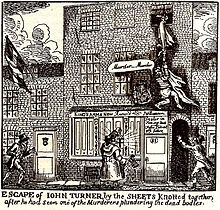In December
1811, London was horrified by two murderous attacks on families in Wapping
district within twelve days, claiming seven lives. Wapping was then a major
port area full of docks and warehouses, businesses catering to the seafaring
trade and sailors, full of low taverns, and brothels. It was a derelict and
often violent neighbourhood, but it had never experienced anything like what
happened in 1811.
The first
attack took place on December 7, at 29 Ratcliffe Highway (now known as The
Highway). The victims were three members of the Marr family and an apprentice who lived in a flat behind the Marr's linen draper’s shop.
At sometime around
midnight, an intruder entered the home and brutally bludgeoned to death Timothy
Marr, his wife Celia, their four weeks old son, and the apprentice, James Gowan.
A blood-stained maul (pictured below) found on the premises with the initials JP or IP was assumed
to be the murder weapon. The Thames River Police investigated but could
discover neither motive nor suspects.
On December
19, a second murderous attack took place nearby at the King’s Arms, a tavern at
81 New Gravel Lane (now Garnet Street). After a constable had heard cries of “Murder!”
a crowd gathered at the premises, where they found a lodger, John Turner, descending
from an upper floor using a rope of knotted sheets.
Turner was crying and nearly
incoherent. Inside, the crowd discovered the bodies of the owner, John
Williamson, his wife Elizabeth, and a servant, Bridget Harrington. Their skulls
were crushed and throats cut. In a bedroom upstairs, they found the Williamson’s
fourteen-year-old granddaughter fast asleep. Amazingly, she had heard nothing.
Bow Street Runners and constables from other districts joined the investigation after the
second attack. (London did not have a centralized, professional police force until 1829). The press and a panicked public were clamouring for a quick arrest
of the killer(s). Within a few days, the police arrested three men as suspects.
One of them, a sailor named John Williams (or Murphy) was a lodger at a Wapping
public house, The Pear Tree. (Image: John Williams, post-mortem sketch).
On December
24, the investigators learned from another lodger that the maul found at Marr’s
shop belonged to a third lodger, John Peterson, who was at sea, and that
Williams could easily have had access to it. Other discoveries led them to focus on
him. Four days later, Williams hanged himself in his cell. The courts quickly ruled him the murderer. But curiously, he did not fit Turner’s description of the man he had seen in the King's Arms. Williams was slender in build and of medium height. All the evidence against him was
circumstantial.
Home
Secretary Richard Ryder, elated by the “solution” of the case, ordered William’s
body to be publicly paraded through the streets of Wapping, and buried at the
crossroads of New Road (now Commercial Road) and Cannon Street Road. The aim
was to reassure the public that the murderer was indeed dead. On New Year’s Eve,
the body was removed from the prison on a cart and followed by a huge procession
estimated to be around 180,000 persons. The procession was the subject of many contemporary images.
The marchers stopped before the houses of the victims before proceeding to the intersection named. A stake was driven through William's heart and he was placed in an already dug
grave. At the time, suicides could not be buried in consecrated (church) ground
and the stake was supposed to prevent his soul from wandering.
Debate continues
today about whether Williams was indeed the killer, or merely the unfortunate
scapegoat of authorities eager to appease the public clamor and panic. Other
suspects have been considered, but the true identity of the Ratcliffe Highway
Murderer remains a mystery, much like the identity of the Whitechapel Murderer, Jack the Ripper.
Further Reading:
T.A. Critchley and P. D. James, The Maul
and the Pear Tree: The Ratcliffe Highway Murders, 1811. London, 1971.






